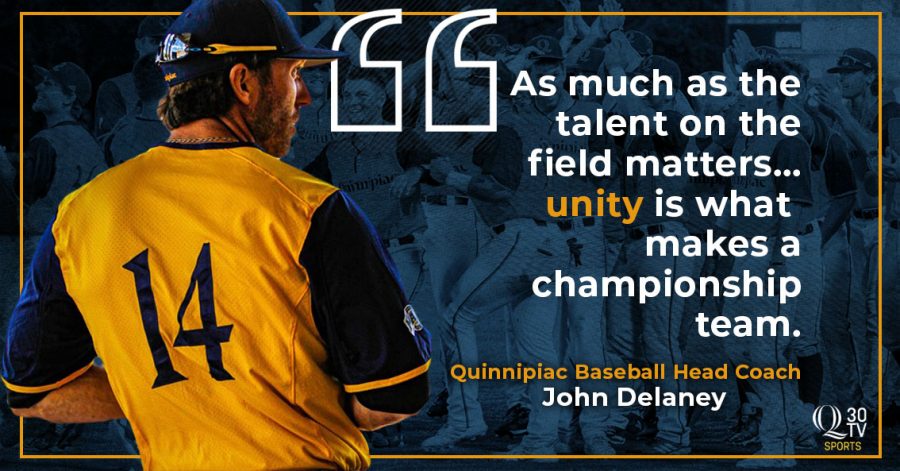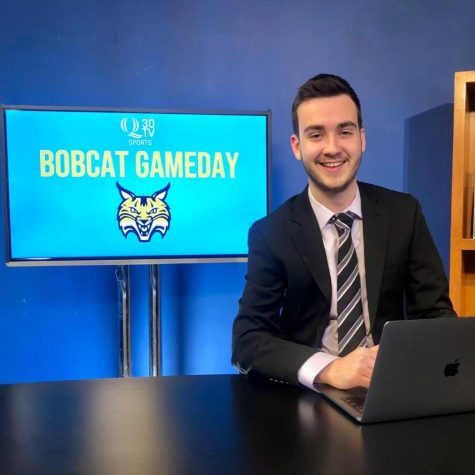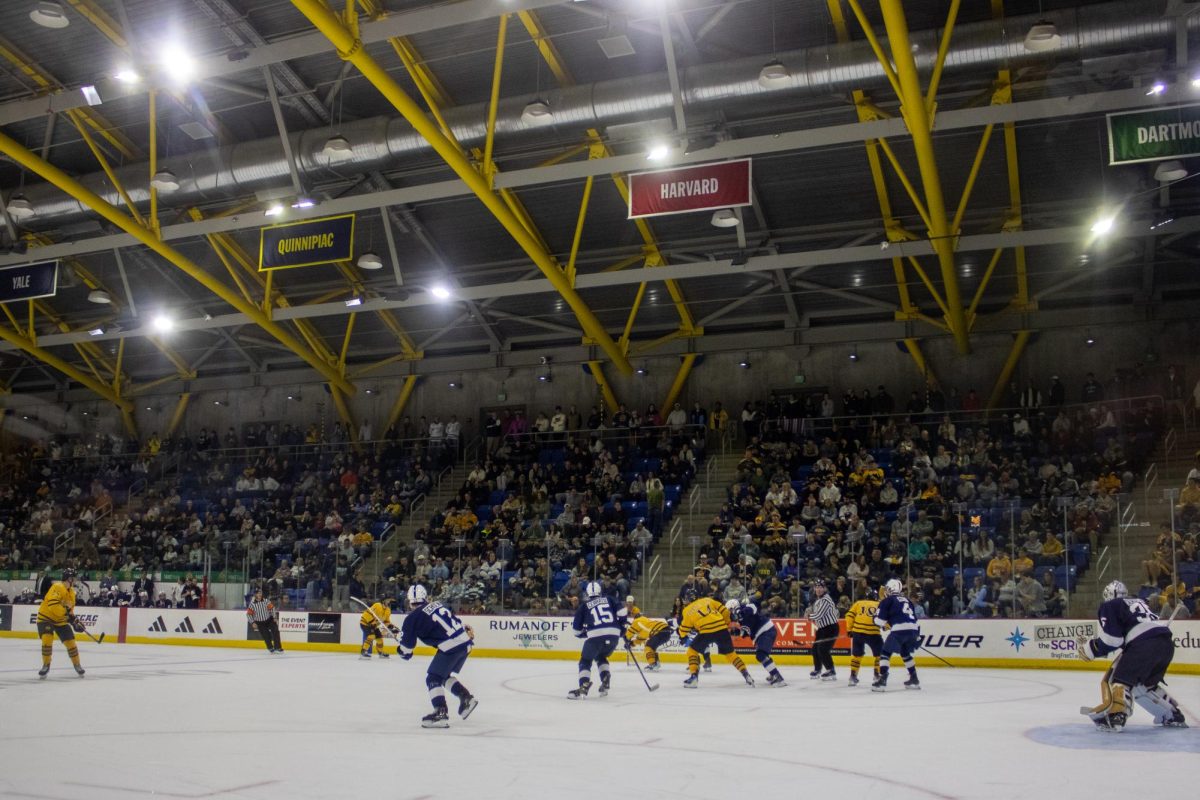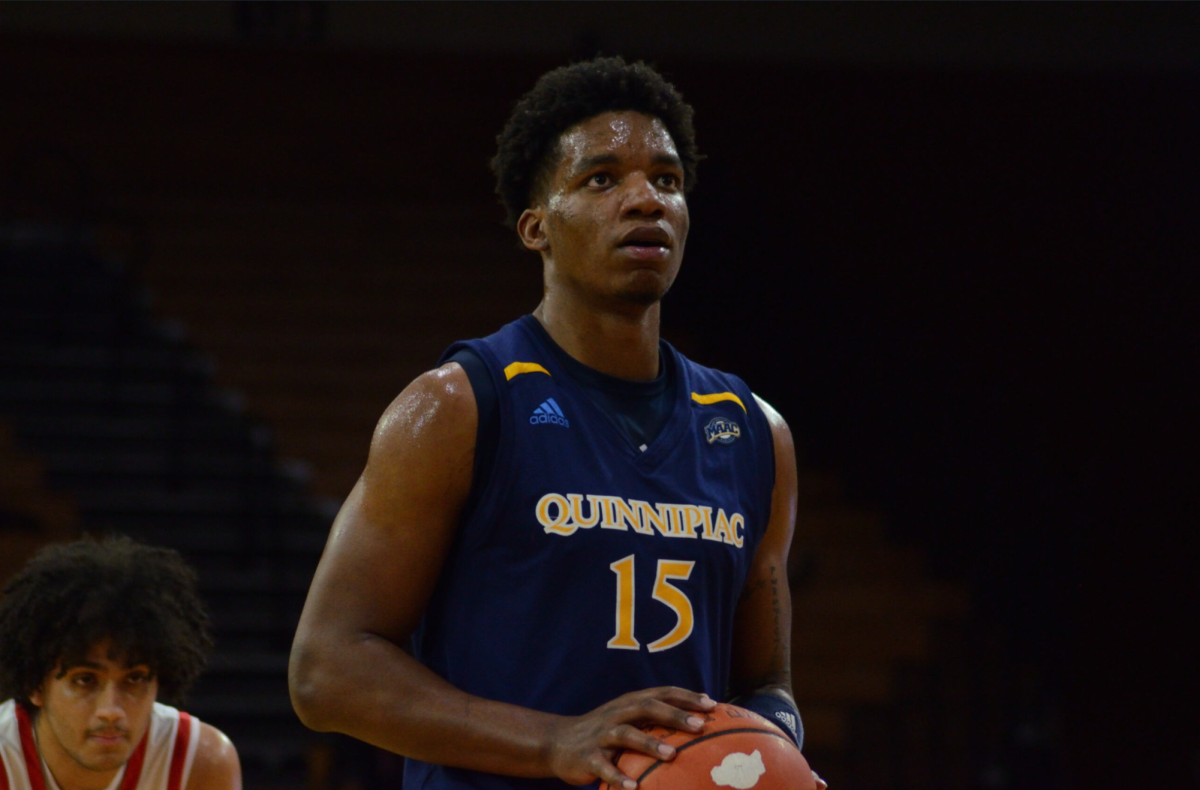One year after tournament win, Quinnipiac baseball looks to the future
June 1, 2020
Follow @Jacob_Resnick
Follow @Q30Sports
One year after the biggest win in program history, the Quinnipiac baseball team should have been making a run at a repeat.
Instead, COVID-19 had other plans.
It was 366 days ago, June 1, 2019, when the Bobcats pulled off an improbable upset to take down the East Carolina University Pirates at the Greenville Regional for the team’s first-ever NCAA Tournament win.
The name “Liam Scafariello,” which had already etched itself into the Quinnipiac record books with his program-best 45 home runs, added an entirely new page with a titanic two-run blast over the left field fence in the seventh inning to put away ECU for good.
BREAKING: This ball just landed in Raleigh after traveling an approximate 443,520 feet! #RoadToOmaha | @TheQBaseball pic.twitter.com/XlJiIH8qGd
— NCAA Baseball (@NCAACWS) June 2, 2019
Colin Donnelly, fresh off 12.2 scoreless innings of relief in the Metro Atlantic Athletic Conference Tournament the week prior, added 2.1 more to cap off Chris Enns‘ excellent start — 6.2 innings, three runs (one earned) allowed, six strikeouts, one walk.
The payoff was not only immediate in the sheer excitement of the win, but also gave the Quinnipiac name an extra edge as head coach John Delaney set out on the recruiting trail in the summer.
“I think the exposure and national recognition changed a lot,” Delaney said. “When [potential recruits] got phone calls from us or coaches found out that we were talking to their players, they were more proactive in the discussions. Once the players were told like ‘Hey, take a look at what they did in the postseason,’ I think that opened up a lot of guys.”
Despite an unsurprising exit at the end of the weekend North Carolina, emotions rode at an all-time high for the first Quinnipiac team to extend its season past the conference tournament since 2005. Questions loomed as to how the program would fill the holes left by key graduates, but the objective during the offseason quickly shifted to focusing on group that would be going into battle the following spring.
And for that team, which opened up its season in February at the University of Texas at San Antonio, the challenge was bigger than who was there and who wasn’t.
“We had to understand that this is the year that’s the hardest,” Delaney said. “You’ve shown that you’ve won and can be extremely competitive at the national level so you’re going to have a target. It was more of not going into this season thinking we were going to be good again and just staying focused on the fact that nobody in our conference has ever won it in back-to-back years.”
2020 In Review
The quest to repeat as MAAC champions lasted just 14 games, produced a .214 winning percentage, and came to a halt just as the answers to the questions about the Bobcats’ future started to become clearer.
The coronavirus may have shut things down prematurely, but Delaney’s squad proved it could have made another postseason run had things shaken out normally.
Quinnipiac’s pitching staff, which led the MAAC with a 3.26 in-conference ERA in 2019, had to battle the losses of its three most efficient arms — Enns, the southpaw whose experience paid dividends in the playoffs; Andrew Workman, the 2019 MAAC Reliever of the Year; and Tyler Poulin, who was selected by the Arizona Diamondbacks in the 29th round of the MLB Draft.
Senior Christian Nicolosi stepped forward as the 2020 staff ace, allowing just three earned runs in 15 innings over three starts. Senior Blake DeCarr was right behind him, pitching into the sixth inning in both of his starts while allowing only three total earned runs.
Out of the bullpen, junior Connor Mahoney posted an 0.79 ERA in six appearances with 14 strikeouts.
“The biggest thing with [DeCarr] was he had pitched sporadically over the course of his first three years and then all of a sudden he’s a weekend starter towards the end of our shortened season,” Delaney said. “That was a big piece that was pleasing to see. We were pitching at such a high level that we knew once the offense started going the right way, we were going to be really hard to beat.”
Though the Bobcats returned four of their top five run producers from a season ago, the graduations of Scafariello, Brian Moskey, Kevin Huscher, and Anthony Cruz hurt from an experience standpoint.
When this year’s team scored just four runs in its first five games, one could have wondered whether the losses were too great to overcome.
“You’re coming off a season where you had so much success offensively that you walk into this year and guys have a lot of excitement but they feel like they’re just going to walk on the field and be really good,” Delaney said. “And when you kind of get punched in the face it sets you back a little bit and you start putting pressure on. So it was getting guys to relax again and understand how good they can be.”
The flip switched around the third series of the season, at Virginia Military Institute, and the lineup averaged nearly six runs per game from there on out.
Though expected contributors like senior Andre Marrero and junior Colton Bender struggled, senior Evan Vulgamore (.946 OPS) and sophomore Michael Kohn (.917 OPS) stepped forward to buoy the attack.
The first run scored in 2020 for @TheQBaseball comes courtesy of a home run by Evan Vulgamore. It gives the Bobcats a 1-0 lead in the second inning. #MAACBaseball pic.twitter.com/BYAiVbmSkf
— Jacob Resnick (@Jacob_Resnick) February 15, 2020
What the Future Holds
Once again, the vision now turns to the following season. But as the entire collegiate athletics world navigates these uncharted waters, Quinnipiac baseball will have to take whatever the future offers.
The NCAA granted an extra year of eligibility to all of its spring athletes, which means seniors like Vulgamore, Nicolosi, and others would be able to return in 2021. Whether or not they are able to take advantage of the opportunity remains to be seen.
Though all but one 2020 senior, Kyle Horton, have expressed a desire to return to Hamden, the school can only offer scholarship money up to what each player was given the previous season. Though those figures won’t count against the typical 11.7 scholarship limit, a mid-major program like Quinnipiac isn’t exactly overflowing with cash.
Understandably, four seniors — including Vulgamore and Marrero — have entered their names into the transfer portal, according to D1Baseball.com. Which seniors do in fact return, which transfer, and which leave college baseball altogether, will adjust the Bobcats’ contention timeline as they pursue another MAAC title.
If Vulgamore and Marrero do return, Quinnipiac has another year with two power bats in the heart of the order. If not, the onus is on Kohn, Kyle Maves, and Braydon Seaburg, among others, to become consistent offensive threats. Ian Ostberg’s defensive versatility, regardless of his 2021 teammates, will be relied on heavily.
If Nicolosi, DeCarr, and Donnelly return, the pitching that looked promising through 14 games in 2020 will have another chance to prove its worth over a full season. If not, inexperienced arms like Brandyn Garcia, Kevin Seitter, Gabriel Romano, and Derek Goldrick will suddenly be thrust into high-leverage roles without the low-leverage reps they would have gotten this past season.
That’s even before mentioning 2021’s incoming first years, a class, unofficially, almost twice as large as 2020’s.
“There are a lot of teams out there that are going to be more competitive because they are going to have a lot of kids back and rosters are going to be a bit older over the next couple of years, but I think our model of ball and our model of recruiting isn’t going to change,” Delaney said.
“But to be honest if some of these kids are able to come back and play an extra year then it only makes the program better and it keeps that unity and trust that has been built over the years.
“And as much as the talent on the field matters, it’s the root — the unity is what makes a championship team.”
The unity is what made the championship team in 2019, and it is undoubtedly what will make another future Bobcat title squad — perhaps sooner rather than later.







